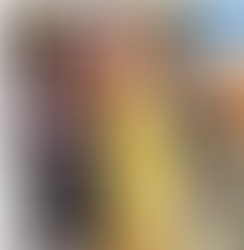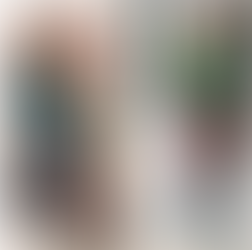Fashion Over The Years
- Luísa Rodarte

- Mar 14, 2022
- 4 min read
Fashion isn't always determined based on the most beautiful style, or the most expensive and fancier type of clothing, but rather on the evolution of clothing and what is most popular at the moment -whether it being because it's visually appealing or because it is comfortable/useful.
Several years ago the only function of clothing was to hide nudity and protect oneself from the cold, rain, and heat. Later on, they discovered that using animal skin as clothing made them warmer, and protected it from fur and thorns. With the development of society people didn't need to care as much about their survival and could instead focus on aesthetics/beauty, so a bit later they began to use cloth, wrapping it around their bodies and changing its color.
All of these changes in clothing that I have mentioned were developments in fashion, since in each era most people wore these specific types of clothing, either for beauty, or for necessity.
1920
This era was right after World War I (which ended in 1914), so people started to wear more casual clothes, with thinner and looser fabric. Girls would typically wear loose dresses, so their curves wouldn't be showcased, and silk was the best fabric for them at that time. They were also not wearing long hair anymore, but shorter, and wearing make-up with a red lipstick and black eyes. Men, on the other hand, wore suits, both in urban and rural areas, and sometimes a jacket.
1930
Differently from the ‘20s, during the 30s women's curves would be showcased, the skirts started to get longer, hair got new lengths, and the back was also highly valued. In men's clothing, double-breasted jackets have become a trend.
1940
In the 40s, women's clothes contained rounded shoulders, wide sleeves, full bodices, and a marked waist, as it showcased a more romantic look. Men's wardrobe also changed, narrower jackets gave way to longer suits, accompanied by wider and high-waisted pants. Sweaters also started to be part of men's clothing in more informal events.
1950
Color and volume is the hallmark of the 1950s. Voluminous skirts and dresses full of petticoats, with stripes, plaids, abstract and floral prints were all very popular at the time. Typically, the length was halfway down the calf. The skirts also had several models, such as godé, pleated, and fringed. Men started to wear more sober clothes, and their pieces would be in fabrics like cotton, wool, flannel, plaid, and tweed. Cardigans instead of vests, short narrow pants, bright colors, shorts, and socks were worn during the summer.
1960
The short pieces arrive with everything in the women's closet of the '60s. Prints of poá, floral, geometric, stripes, and unisex looks, pieces that were once worn by men are now worn by women, such as tuxedos, because to blur or cross gender lines. Straight cut dresses, short tube dresses were also popular at the time. The miniskirt appears, and bikinis become popular with models such as hot pants and bandeau tops. The Beatles also became a reference in the ‘60s for male fashion. Trends that were brought forward include collarless jackets, very tight pants, low waist, with red and pink being the predominant colors in t-shirts. The more popular hairstyles have more length, and vinyl shoes bring modernity.
1970
The 1970s make way for the hippie era, due to the influence of the Woodstock festival (a festival wich people to escape into music and spread a message of unity and peace) The psychedelic style is seen in the clothes, in the form of drawings, colors, and tie-dyeing. The vests predominate in both denim and leather. Tunics, miniskirts, and long skirts are essential pieces, as well as bell-bottom jeans with ornaments. Men started to wear more accessories, from rings to bracelets and purses. The shirts were made of polyester with pointed collars, tergal pants, with a variety of colors and prints.
1980
The fashion of this year was a very masculine style for the girls, because they competed in the job market in the management position with men, and this gave the women the "yuppie" style. They wore a lot of high-waisted pants, shoulder pads, tailleurs, balloon skirts and puffed sleeves, mixed pieces and different prints were also very fashionable. For men, the moccasin, in more sober versions and also in more vibrant colors. The colorful and extravagant jackets, decorated with an infinity of zippers and garments that had a military touch, were the most successful among the male public.
1990
Different from the ‘80s, where extravagance and colors reigned, the beginning of the 90s is marked by minimalism, neutral colors, and few compositions in the looks. This is until the grunge style, bringing flannel shirts and torn pants due to the rock influence from the end of the 80s. Just as they were in the ‘70s, high-waisted pants are back with everything, enhancing the female silhouette. The "john-style" haircut is adhered to by women, as well as the box braids, inspired by the Jamaican style. Pieces such as shirts, jackets, and overalls start to dominate the male closet!
2000
The 2000s had various reinterpretations by including trends from the 60s, 70s, 80s, and the minimalist footprint of the 90s. At the beginning of the decade, women wore many denim miniskirts, jackets, tops, sandals, and ripped jeans, the colors were very present, the modern fabrics that change color. The pants became skinny, very tight, and low waisted, tunics with belts on the waist, leggings, high boots with thin beaks, and capri pants also became part of the women's wardrobe. Men in the 2000s, in general, go back to retro fashion -black leather jackets, Ed Hardy style shirts, biker boots, V-neck blouses, and Ray-Ban jackets and sunglasses.




































Comments